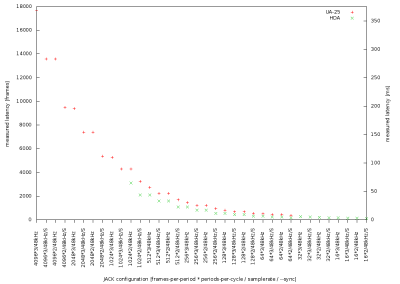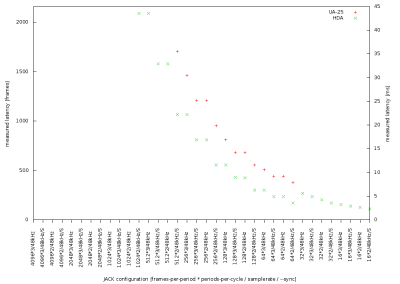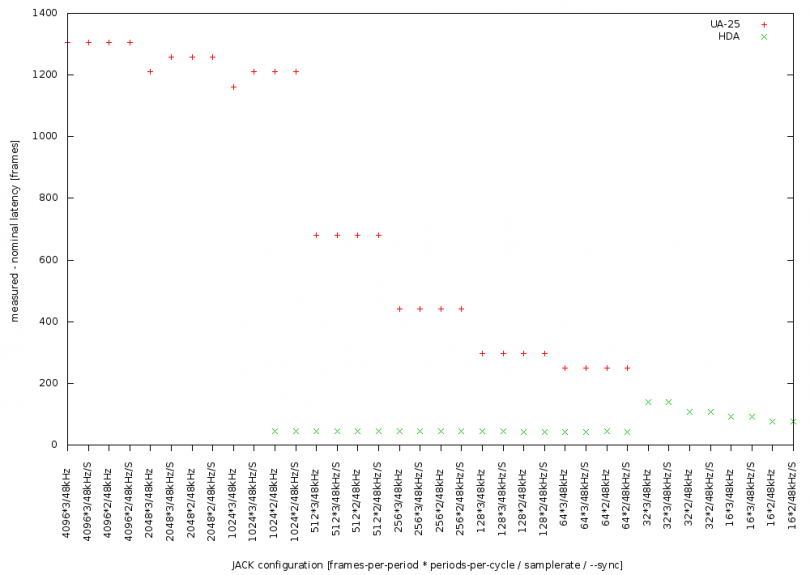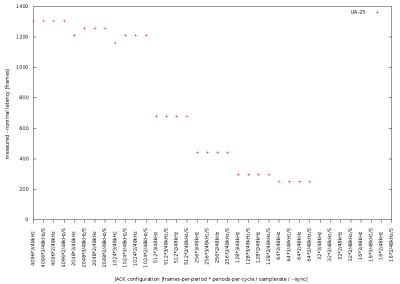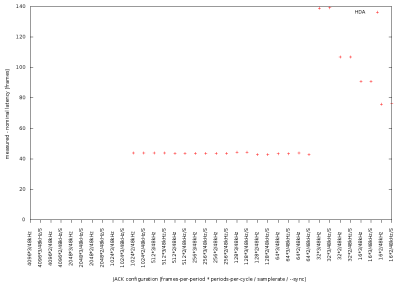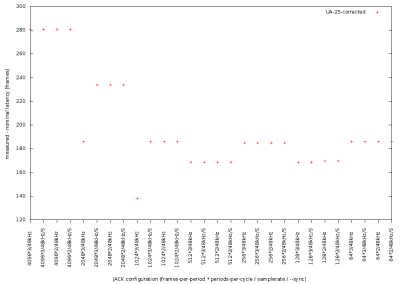This is an old revision of the document!
Table of Contents
JACK Latency tests
Yet to be interpreted results on measuring JACK latency.
Introduction
There are only a few use-cases where latency - the delay between a signal arriving at the sound-card's (analog) input until it arrives at the output of the sound-card again - is important to be very low.
In most other cases (such as playback, recording) latency can be compensated for, however any path that requires direct In→Out processing will need a low-latency system. In particular low-latency audio is required for
- live-effects
- live-mixing
- software monitoring
- playing virtual instruments
Most humans will notice no difference if the audio latency is below 10ms (citation needed) - for comparison: in 10ms the sound travels ~ 3.4m (11 feet).
The JACK Audio Connection Kit has a few parameters to configure the latency. However the settings are constrained by hardware (audio-device, CPU and bus-speed). Lower latencies increase the load on the computer-system (it needs to process the audio in smaller chunks which arrive much more frequently). If the system can not keep up: an x-run (short for buffer over-run and buffer under-run) occurs which usually results in audible clicks or dropouts.
Stable low-latency (⇐10ms) on GNU/Linux can usually only be achieved by running realtime-kernel (insert links to rtirq and setup/config info here).
JACK Latency enigma
JACK does report the port-latencies (run jack_lsp -l). However the values it reports for physical-ports are determined by the configuration (e.g. -p 1024 -n3) and do not represent the real latency.
The total latency depends on many variables: the bus (PCI, 1394, USB), layers in between (DMA, IRQ) and of course the audio-interface itself.
Latency measurements
Fons Adriaensen has written a small utility to measure the total round-trip latency called jack_delay.
Even though the complete path of the digital audio-signal that causes latency is complicated due to data-packet-framing, bus-latencies, we expect patterns.
The diagrams below show the the measured-latency for an Edirol UA-25 USB and a HDA-Intel PCI sound-card. Note that not all configurations are possible: e.g. for USB interface the frames-per-period need to be larger or equal to 64 frames, while the HDA will not allow periods larger than 2048 frames.
The tests were done on Debian/squeeze using jackdmp 1.9.6.
Interpretation and Analysis
Let's have a closer look.
The diagrams below show the difference of the nominal-latency (given by JACK configuration - and also displayed in the qjackctl setup dialog) and the measured-latency for an Edirol UA-25 USB and a HDA-Intel PCI sound-card.
The small residue of additional non-JACK-latency for PCI devices is consistent. The anomalies ≤ 32 frames/period for PCI devices can be explained by bus overhead and the soundcard. However the results for USB-device is unexpected.
There's two things that the authors of this article do not understand (and may be bugs in JACK).
- It seems that for USB devices JACK secretly adds an additional period latency (but at most 1024 frames) that is not present with PCI devices.
- latency reported by JACK is inconsistent:
Looking closer at these two issues:
(1) plotting the non-JACK-latency for the USB device after subtracting an additional period-size - but at most 1024 frames yields a reasonable pattern:
(2) understanding the inconsistencies of reported port-latency will require digging into the source-code of JACK, it may also help to try to reproduce this behaviour with jack-1. It may simply be a misinterpretation of the reported values. The information collected here is a first step: to make the issue clear to the authors.
using -n2 for either USB or PCI makes JACKd report during startup:
ALSA: use 2 periods for capture ALSA: use 2 periods for playback
and -n3 reports:
ALSA: use 3 periods for capture ALSA: use 3 periods for playback
while jack_lsp -l (or jack_port_get_latency) says otherwise. For -n3 -p1024:
system:capture_1
port latency = 1024 frames
system:playback_1
port latency = 2048 frames
References
Raw data
#UA-25, Linux 2.6.33.7-rt29 i386, jackdmp 1.9.6 #JACK-cfg, measured lat [frames], measured lat [ms], nominal latency for record [frames], nominal latency for playback [frames], periods per cycle #JACK-cfg: frames per period * periods per cycle / sample-rate / S: --sync # # values of '-1' mean that this mode is not supported # 4096*3/48kHz ,17688.747, 368.516, 4096,12288, 3 4096*3/48kHz/S ,13592.747, 283.182, 4096, 8192, 3 4096*2/48kHz ,13592.747, 283.182, 4096, 8192, 2 4096*2/48kHz/S , 9496.747, 197.849, 4096, 4096, 2 2048*3/48kHz , 9401.749, 195.870, 2048, 6144, 3 2048*3/48kHz/S , 7401.747, 154.203, 2048, 4096, 3 2048*2/48kHz , 7401.747, 154.203, 2048, 4096, 2 2048*2/48kHz/S , 5353.747, 111.536, 2048, 2048, 2 1024*3/48kHz , 5257.748, 109.536, 1024, 3072, 3 1024*3/48kHz/S , 4281.748, 89.203, 1024, 2048, 3 1024*2/48kHz , 4281.749, 89.203, 1024, 2048, 2 1024*2/48kHz/S , 3257.746, 67.870, 1024, 1024, 2 512*3/48kHz , 2728.747, 56.849, 512, 1536, 3 512*3/48kHz/S , 2216.747, 46.182, 512, 1024, 3 512*2/48kHz , 2216.748, 46.182, 512, 1024, 2 512*2/48kHz/S , 1704.748, 35.516, 512, 512, 2 256*3/48kHz , 1464.747, 30.516, 256, 768, 3 256*3/48kHz/S , 1208.748, 25.182, 256, 512, 3 256*2/48kHz , 1208.747, 25.182, 256, 512, 2 256*2/48kHz/S , 952.747, 19.849, 256, 256, 2 128*3/48kHz , 808.748, 16.849, 128, 384, 3 128*3/48kHz/S , 680.747, 14.182, 128, 256, 3 128*2/48kHz , 681.748, 14.203, 128, 256, 2 128*2/48kHz/S , 553.748, 11.536, 128, 128, 2 64*3/48kHz , 505.748, 10.536, 64, 192, 3 64*3/48kHz/S , 441.747, 9.203, 64, 128, 3 64*2/48kHz , 441.748, 9.203, 64, 128, 2 64*2/48kHz/S , 377.747, 7.870, 64, 64, 2 32*3/48kHz , -1 , -1 , 32, 96, 3 32*3/48kHz/S , -1 , -1 , 32, 64, 3 32*2/48kHz , -1 , -1 , 32, 64, 2 32*2/48kHz/S , -1 , -1 , 32, 32, 2 16*3/48kHz , -1 , -1 , 16, 48, 3 16*3/48kHz/S , -1 , -1 , 16, 32, 3 16*2/48kHz , -1 , -1 , 16, 32, 2 16*2/48kHz/S , -1 , -1 , 16, 16, 2
#HDA 1458:a002, Linux 2.6.33.7-rt29 amd64, jackdmp 1.9.6 #JACK-cfg, measured lat [frames], measured lat [ms], nominal latency for record [frames], nominal latency for playback [frames], periods per cycle #JACK-cfg: frames per period * periods per cycle / sample-rate / S: --sync # # values of '-1' mean that this mode is not supported # #2048*2 -> ALSA: cannot configure playback channel #1024*3 -> ALSA: cannot configure playback channel # 4096*3/48kHz , -1 , -1 , 4096,12288, 3 4096*3/48kHz/S , -1 , -1 , 4096, 8192, 3 4096*2/48kHz , -1 , -1 , 4096, 8192, 2 4096*2/48kHz/S , -1 , -1 , 4096, 4096, 2 2048*3/48kHz , -1 , -1 , 2048, 6144, 3 2048*3/48kHz/S , -1 , -1 , 2048, 4096, 3 2048*2/48kHz , -1 , -1 , 2048, 4096, 2 2048*2/48kHz/S , -1 , -1 , 2048, 2048, 2 1024*3/48kHz , -1 , -1 , 1024, 3072, 3 1024*3/48kHz/S , -1 , -1 , 1024, 2048, 3 1024*2/48kHz ,3115.933, 64.915, 1024, 2048, 2 1024*2/48kHz/S ,2091.965, 43.583, 1024, 1024, 2 512*3/48kHz ,2091.739, 43.578, 512, 1536, 3 512*3/48kHz/S ,1579.792, 32.912, 512, 1024, 3 512*2/48kHz ,1579.729, 32.911, 512, 1024, 2 512*2/48kHz/S ,1067.693, 22.244, 512, 512, 2 256*3/48kHz ,1067.631, 22.242, 256, 768, 3 256*3/48kHz/S , 811.610, 16.909, 256, 512, 3 256*2/48kHz , 811.640, 16.909, 256, 512, 2 256*2/48kHz/S , 555.678, 11.577, 256, 256, 2 128*3/48kHz , 556.381, 11.591, 128, 384, 3 128*3/48kHz/S , 428.372, 8.924, 128, 256, 3 128*2/48kHz , 426.775, 8.891, 128, 256, 2 128*2/48kHz/S , 298.726, 6.223, 128, 128, 2 64*3/48kHz , 299.280, 6.235, 64, 192, 3 64*3/48kHz/S , 235.297, 4.902, 64, 128, 3 64*2/48kHz , 235.833, 4.913, 64, 128, 2 64*2/48kHz/S , 170.797, 3.558, 64, 64, 2 32*3/48kHz , 267.078, 5.564, 32, 96, 3 32*3/48kHz/S , 235.163, 4.899, 32, 64, 3 32*2/48kHz , 202.842, 4.226, 32, 64, 2 32*2/48kHz/S , 170.943, 3.561, 32, 32, 2 16*3/48kHz , 155.007, 3.229, 16, 48, 3 16*3/48kHz/S , 138.963, 2.895, 16, 32, 3 16*2/48kHz , 124.041, 2.584, 16, 32, 2 16*2/48kHz/S , 108.056, 2.251, 16, 16, 2
Acknowledgments
Many thanks to Paul Davis and Stephane Letz for JACK and Fons Adriaensen for jack_delay.
This article was written by Robin Gareus and Luis Garrido and may be redistributed in terms of the GFDL.

